ラフレシア・アーノルディ(標本)

ラフレシア・アーノルディの花と蕾を標本の状態でご覧いただけます。(公益財団法人・国際花と緑の博覧会記念協会所有)
ラフレシア属は東南アジアで長年ラフレシアの研究をされていたW.メイヤーにより分類、約28種とされていましたが、2020年分子系統の研究では18種に整理されています。
ラフレシア・アーノルディは直径1mを超え、重量10kgと世界最大の花です。よく引き合いに出されるショクダイオオコンニャクは植物学的にいうと小さな花の集まりで、比較の対象にはなりません。雄花から雌花への花粉運びはハエにより、果実はツパイなど森の生物が食べます。ブドウ科のテトラスティグマ・レイコスタフィルムなどに寄生して生育し、人工栽培は困難です。現地ではエコツーリズムによるラフレシア観察が行われていますが、観光用開発の影響もあり各地で花を見られる機会が減ってきているそうです。
Specimen of a flower and a bud of Rafflesia arnoldii is displayed.
Rafflesia is a genus of parasitic flowering plants belonging to Rafflesiaceae. The genus Rafflesia contains approximately 28 species (including four incompletely characterized species as recognized in 1997 by Willem Meijer in the monograph on the genus)
A 2020 molecular phylogenetic study of 18 species of Rafflesia found that they fell into four clear-cut geographically (Philippines,Pen.Malaysia,Sumatra+Java,Borneo), defined groups. Rafflesia arnoldii, the flower may be over 100 cm. in diameter, and weigh up to 10 kg. Usually as a parasite on Tetrastigma leucostaphylum
The buds rising from the ground or directly from the lower stems of their host plants Tetrastigma. One species, Rafflesia arnoldii has the largest flowers in the world. Amorphophallus has the world's largest unbranched inflorescence, it is sometimes mistakenly credited as having the world's largest flower.
The flowers look and smell like rotting flesh. The foul odour attracts insects such as carrion flies, which transport pollen from male to female flowers. Little is known about seed dispersal. Tree shrews , ground squirrels and other forest mammals eat the fruits. The tiny seeds have extremely tiny elaiosomes, and are thus most likely dispersed by ants.
Hundreds of thousands of seeds are packed into berries.
Sightseeing of Rafflesia is now popular with tourists.
Unfortunately, as a result of this ecotourism and the resulting human disturbance, the number of flower buds produced per year has decreased significantly at many sites.






